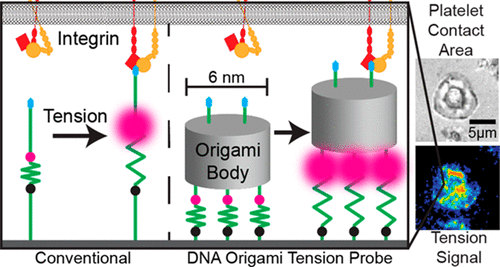当前位置:
X-MOL 学术
›
Nano Lett.
›
论文详情
Our official English website, www.x-mol.net, welcomes your
feedback! (Note: you will need to create a separate account there.)
Programmable Multivalent DNA-Origami Tension Probes for Reporting Cellular Traction Forces
Nano Letters ( IF 9.6 ) Pub Date : 2018-06-18 00:00:00 , DOI: 10.1021/acs.nanolett.8b01374 Palash K Dutta , Yun Zhang 1 , Aaron T Blanchard , Chenghao Ge , Muaz Rushdi , Kristin Weiss , Cheng Zhu , Yonggang Ke 1 , Khalid Salaita 1
Nano Letters ( IF 9.6 ) Pub Date : 2018-06-18 00:00:00 , DOI: 10.1021/acs.nanolett.8b01374 Palash K Dutta , Yun Zhang 1 , Aaron T Blanchard , Chenghao Ge , Muaz Rushdi , Kristin Weiss , Cheng Zhu , Yonggang Ke 1 , Khalid Salaita 1
Affiliation

|
Mechanical forces are central to most, if not all, biological processes, including cell development, immune recognition, and metastasis. Because the cellular machinery mediating mechano-sensing and force generation is dependent on the nanoscale organization and geometry of protein assemblies, a current need in the field is the development of force-sensing probes that can be customized at the nanometer-length scale. In this work, we describe a DNA origami tension sensor that maps the piconewton (pN) forces generated by living cells. As a proof-of-concept, we engineered a novel library of six-helix-bundle DNA-origami tension probes (DOTPs) with a tailorable number of tension-reporting hairpins (each with their own tunable tension response threshold) and a tunable number of cell-receptor ligands. We used single-molecule force spectroscopy to determine the probes’ tension response thresholds and used computational modeling to show that hairpin unfolding is semi-cooperative and orientation-dependent. Finally, we use our DOTP library to map the forces applied by human blood platelets during initial adhesion and activation. We find that the total tension signal exhibited by platelets on DOTP-functionalized surfaces increases with the number of ligands per DOTP, likely due to increased total ligand density, and decreases exponentially with the DOTP’s force-response threshold. This work opens the door to applications for understanding and regulating biophysical processes involving cooperativity and multivalency.
中文翻译:

用于报告细胞牵引力的可编程多价 DNA 折纸张力探针
机械力是大多数(如果不是全部)生物过程的核心,包括细胞发育、免疫识别和转移。由于介导机械传感和力产生的细胞机制取决于蛋白质组装体的纳米级组织和几何形状,因此该领域当前的需求是开发可以在纳米长度尺度上定制的力传感探针。在这项工作中,我们描述了一种 DNA 折纸张力传感器,可以绘制活细胞产生的皮牛顿 (pN) 力。作为概念验证,我们设计了一个新型六螺旋束 DNA 折纸张力探针 (DOTP) 文库,其中包含可定制数量的张力报告发夹(每个发夹都有自己可调的张力响应阈值)和可调数量细胞受体配体。我们使用单分子力谱来确定探针的张力响应阈值,并使用计算模型来表明发夹展开是半合作且依赖于方向的。最后,我们使用 DOTP 库来绘制人类血小板在初始粘附和激活过程中所施加的力。我们发现,血小板在 DOTP 功能化表面上表现出的总张力信号随着每个 DOTP 的配体数量而增加,这可能是由于总配体密度的增加,并且随着 DOTP 的力响应阈值呈指数下降。这项工作为理解和调节涉及协同性和多价性的生物物理过程的应用打开了大门。
更新日期:2018-06-18
中文翻译:

用于报告细胞牵引力的可编程多价 DNA 折纸张力探针
机械力是大多数(如果不是全部)生物过程的核心,包括细胞发育、免疫识别和转移。由于介导机械传感和力产生的细胞机制取决于蛋白质组装体的纳米级组织和几何形状,因此该领域当前的需求是开发可以在纳米长度尺度上定制的力传感探针。在这项工作中,我们描述了一种 DNA 折纸张力传感器,可以绘制活细胞产生的皮牛顿 (pN) 力。作为概念验证,我们设计了一个新型六螺旋束 DNA 折纸张力探针 (DOTP) 文库,其中包含可定制数量的张力报告发夹(每个发夹都有自己可调的张力响应阈值)和可调数量细胞受体配体。我们使用单分子力谱来确定探针的张力响应阈值,并使用计算模型来表明发夹展开是半合作且依赖于方向的。最后,我们使用 DOTP 库来绘制人类血小板在初始粘附和激活过程中所施加的力。我们发现,血小板在 DOTP 功能化表面上表现出的总张力信号随着每个 DOTP 的配体数量而增加,这可能是由于总配体密度的增加,并且随着 DOTP 的力响应阈值呈指数下降。这项工作为理解和调节涉及协同性和多价性的生物物理过程的应用打开了大门。











































 京公网安备 11010802027423号
京公网安备 11010802027423号